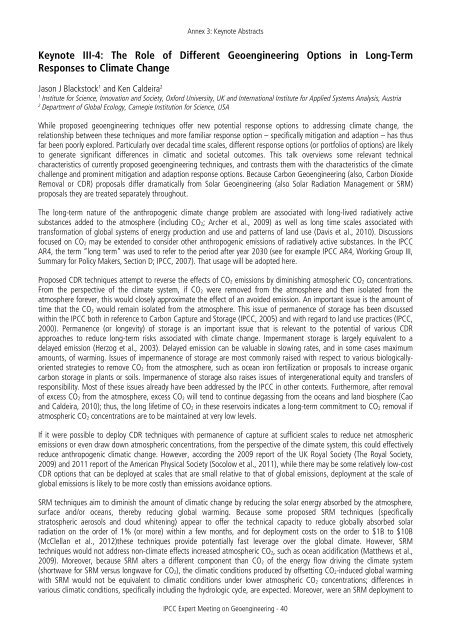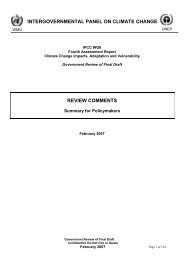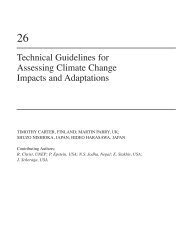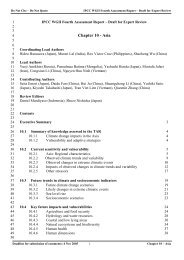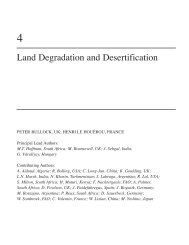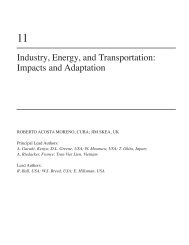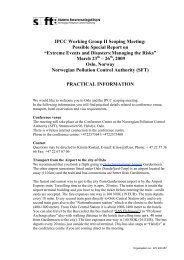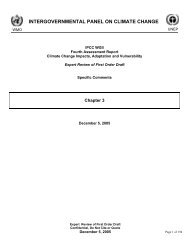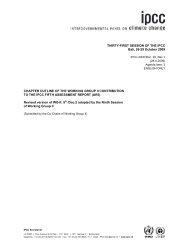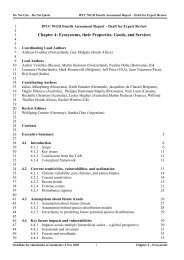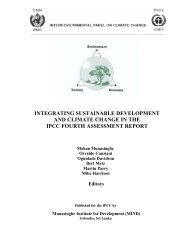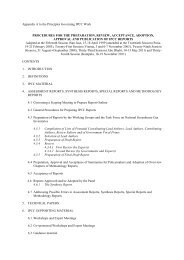IPCC Expert Meeting on Geoengineering
IPCC Expert Meeting on Geoengineering
IPCC Expert Meeting on Geoengineering
Create successful ePaper yourself
Turn your PDF publications into a flip-book with our unique Google optimized e-Paper software.
Annex 3: Keynote Abstracts<br />
Keynote III-4: The Role of Different <strong>Geoengineering</strong> Opti<strong>on</strong>s in L<strong>on</strong>g-Term<br />
Resp<strong>on</strong>ses to Climate Change<br />
Jas<strong>on</strong> J Blackstock 1 and Ken Caldeira 2<br />
1<br />
Institute for Science, Innovati<strong>on</strong> and Society, Oxford University, UK and Internati<strong>on</strong>al Institute for Applied Systems Analysis, Austria<br />
2<br />
Department of Global Ecology, Carnegie Instituti<strong>on</strong> for Science, USA<br />
While proposed geoengineering techniques offer new potential resp<strong>on</strong>se opti<strong>on</strong>s to addressing climate change, the<br />
relati<strong>on</strong>ship between these techniques and more familiar resp<strong>on</strong>se opti<strong>on</strong> – specifically mitigati<strong>on</strong> and adapti<strong>on</strong> – has thus<br />
far been poorly explored. Particularly over decadal time scales, different resp<strong>on</strong>se opti<strong>on</strong>s (or portfolios of opti<strong>on</strong>s) are likely<br />
to generate significant differences in climatic and societal outcomes. This talk overviews some relevant technical<br />
characteristics of currently proposed geoengineering techniques, and c<strong>on</strong>trasts them with the characteristics of the climate<br />
challenge and prominent mitigati<strong>on</strong> and adapti<strong>on</strong> resp<strong>on</strong>se opti<strong>on</strong>s. Because Carb<strong>on</strong> <strong>Geoengineering</strong> (also, Carb<strong>on</strong> Dioxide<br />
Removal or CDR) proposals differ dramatically from Solar <strong>Geoengineering</strong> (also Solar Radiati<strong>on</strong> Management or SRM)<br />
proposals they are treated separately throughout.<br />
The l<strong>on</strong>g-term nature of the anthropogenic climate change problem are associated with l<strong>on</strong>g-lived radiatively active<br />
substances added to the atmosphere (including CO 2; Archer et al., 2009) as well as l<strong>on</strong>g time scales associated with<br />
transformati<strong>on</strong> of global systems of energy producti<strong>on</strong> and use and patterns of land use (Davis et al., 2010). Discussi<strong>on</strong>s<br />
focused <strong>on</strong> CO 2 may be extended to c<strong>on</strong>sider other anthropogenic emissi<strong>on</strong>s of radiatively active substances. In the <str<strong>on</strong>g>IPCC</str<strong>on</strong>g><br />
AR4, the term “l<strong>on</strong>g term” was used to refer to the period after year 2030 (see for example <str<strong>on</strong>g>IPCC</str<strong>on</strong>g> AR4, Working Group III,<br />
Summary for Policy Makers, Secti<strong>on</strong> D; <str<strong>on</strong>g>IPCC</str<strong>on</strong>g>, 2007). That usage will be adopted here.<br />
Proposed CDR techniques attempt to reverse the effects of CO 2 emissi<strong>on</strong>s by diminishing atmospheric CO 2 c<strong>on</strong>centrati<strong>on</strong>s.<br />
From the perspective of the climate system, if CO 2 were removed from the atmosphere and then isolated from the<br />
atmosphere forever, this would closely approximate the effect of an avoided emissi<strong>on</strong>. An important issue is the amount of<br />
time that the CO 2 would remain isolated from the atmosphere. This issue of permanence of storage has been discussed<br />
within the <str<strong>on</strong>g>IPCC</str<strong>on</strong>g> both in reference to Carb<strong>on</strong> Capture and Storage (<str<strong>on</strong>g>IPCC</str<strong>on</strong>g>, 2005) and with regard to land use practices (<str<strong>on</strong>g>IPCC</str<strong>on</strong>g>,<br />
2000). Permanence (or l<strong>on</strong>gevity) of storage is an important issue that is relevant to the potential of various CDR<br />
approaches to reduce l<strong>on</strong>g-term risks associated with climate change. Impermanent storage is largely equivalent to a<br />
delayed emissi<strong>on</strong> (Herzog et al., 2003). Delayed emissi<strong>on</strong> can be valuable in slowing rates, and in some cases maximum<br />
amounts, of warming. Issues of impermanence of storage are most comm<strong>on</strong>ly raised with respect to various biologicallyoriented<br />
strategies to remove CO 2 from the atmosphere, such as ocean ir<strong>on</strong> fertilizati<strong>on</strong> or proposals to increase organic<br />
carb<strong>on</strong> storage in plants or soils. Impermanence of storage also raises issues of intergenerati<strong>on</strong>al equity and transfers of<br />
resp<strong>on</strong>sibility. Most of these issues already have been addressed by the <str<strong>on</strong>g>IPCC</str<strong>on</strong>g> in other c<strong>on</strong>texts. Furthermore, after removal<br />
of excess CO 2 from the atmosphere, excess CO 2 will tend to c<strong>on</strong>tinue degassing from the oceans and land biosphere (Cao<br />
and Caldeira, 2010); thus, the l<strong>on</strong>g lifetime of CO 2 in these reservoirs indicates a l<strong>on</strong>g-term commitment to CO 2 removal if<br />
atmospheric CO 2 c<strong>on</strong>centrati<strong>on</strong>s are to be maintained at very low levels.<br />
If it were possible to deploy CDR techniques with permanence of capture at sufficient scales to reduce net atmospheric<br />
emissi<strong>on</strong>s or even draw down atmospheric c<strong>on</strong>centrati<strong>on</strong>s, from the perspective of the climate system, this could effectively<br />
reduce anthropogenic climatic change. However, according the 2009 report of the UK Royal Society (The Royal Society,<br />
2009) and 2011 report of the American Physical Society (Socolow et al., 2011), while there may be some relatively low-cost<br />
CDR opti<strong>on</strong>s that can be deployed at scales that are small relative to that of global emissi<strong>on</strong>s, deployment at the scale of<br />
global emissi<strong>on</strong>s is likely to be more costly than emissi<strong>on</strong>s avoidance opti<strong>on</strong>s.<br />
SRM techniques aim to diminish the amount of climatic change by reducing the solar energy absorbed by the atmosphere,<br />
surface and/or oceans, thereby reducing global warming. Because some proposed SRM techniques (specifically<br />
stratospheric aerosols and cloud whitening) appear to offer the technical capacity to reduce globally absorbed solar<br />
radiati<strong>on</strong> <strong>on</strong> the order of 1% (or more) within a few m<strong>on</strong>ths, and for deployment costs <strong>on</strong> the order to $1B to $10B<br />
(McClellan et al., 2012)these techniques provide potentially fast leverage over the global climate. However, SRM<br />
techniques would not address n<strong>on</strong>-climate effects increased atmospheric CO 2, such as ocean acidificati<strong>on</strong> (Matthews et al.,<br />
2009). Moreover, because SRM alters a different comp<strong>on</strong>ent than CO 2 of the energy flow driving the climate system<br />
(shortwave for SRM versus l<strong>on</strong>gwave for CO 2), the climatic c<strong>on</strong>diti<strong>on</strong>s produced by offsetting CO 2-induced global warming<br />
with SRM would not be equivalent to climatic c<strong>on</strong>diti<strong>on</strong>s under lower atmospheric CO 2 c<strong>on</strong>centrati<strong>on</strong>s; differences in<br />
various climatic c<strong>on</strong>diti<strong>on</strong>s, specifically including the hydrologic cycle, are expected. Moreover, were an SRM deployment to<br />
<str<strong>on</strong>g>IPCC</str<strong>on</strong>g> <str<strong>on</strong>g>Expert</str<strong>on</strong>g> <str<strong>on</strong>g>Meeting</str<strong>on</strong>g> <strong>on</strong> <strong>Geoengineering</strong> - 40


